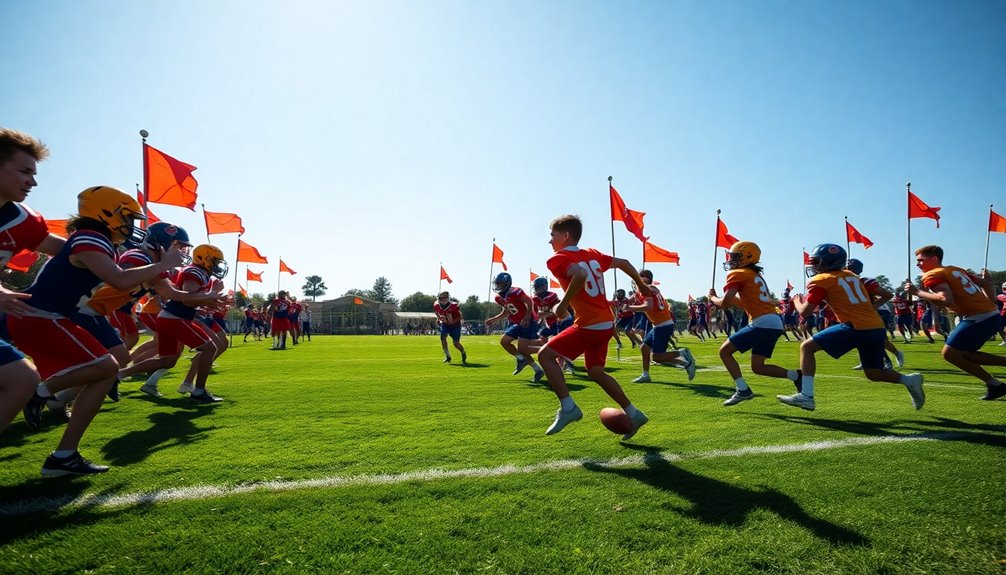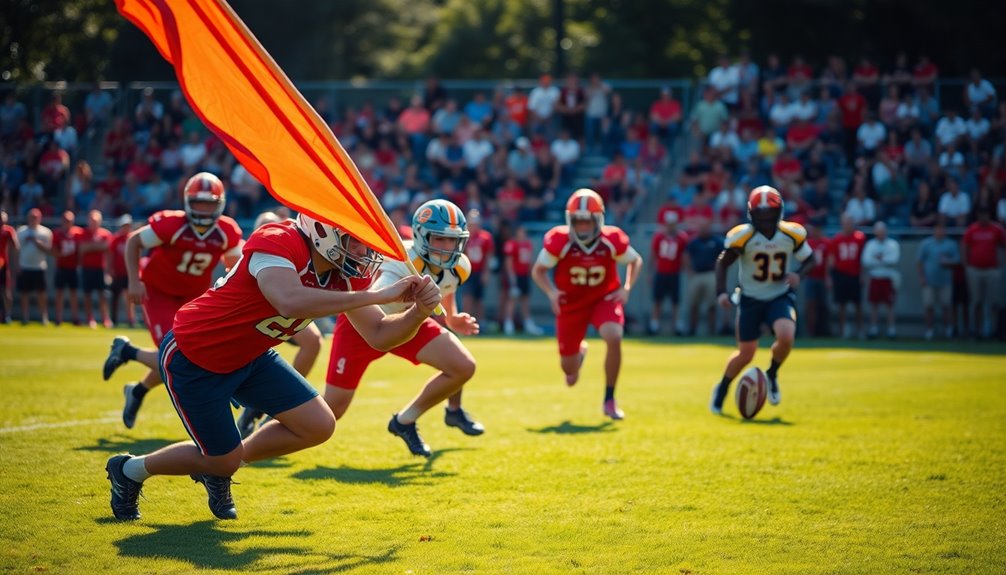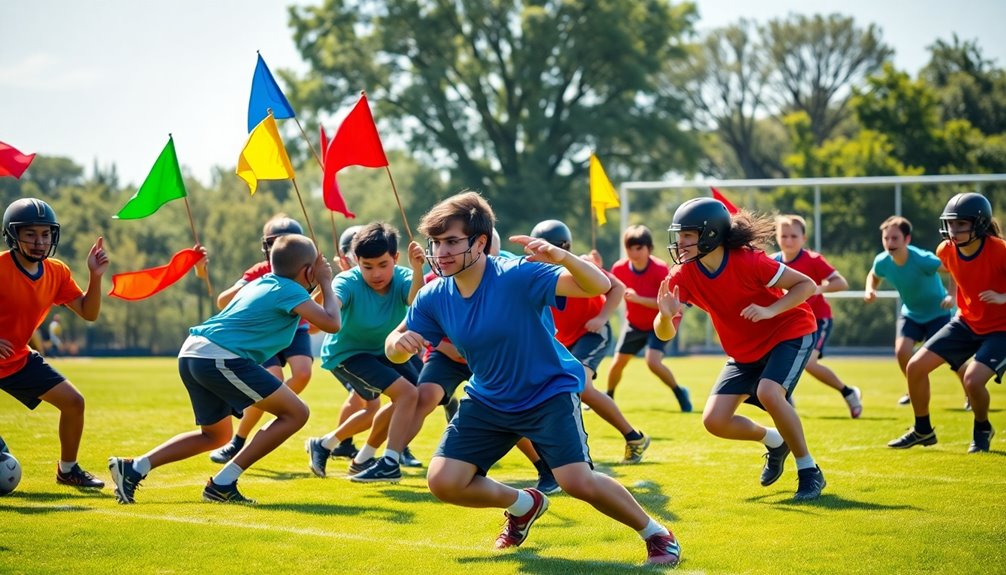
Flag Football Defense Strategies for Every Team
January 12, 2025To enhance your flag football defense, you need strong strategies tailored for your team. Start with essential formations like man-to-man and various zone defenses, such as Cover 2 or Cover 3. Effective flag pulling techniques include focusing on the hips of the ball carrier and using choppy steps to close the distance. Communication is imperative; it helps maintain defensive assignments and builds team cohesion. Practicing these strategies regularly guarantees your team reacts quickly and effectively during games. By mastering these elements, you'll greatly improve your defense and keep your opponents at bay. There's plenty more to discover about advanced tactics!
Overview of Defensive Strategies
A strong defensive strategy is essential in flag football, as it directly influences your team's success on the field. Understanding the various defensive formations, like man-to-man coverage and zone defenses, is key to countering offensive strategies effectively. You can employ formations such as Cover 0 or Cover 1 for tight matchups, while Cover 2 or Cover 3 can provide broader coverage against passing plays. To enhance your team's performance, incorporating endurance training can improve players' stamina and decision-making during defensive plays.
In addition, the 1-3-1 and 2-3-1 zone defenses work well in 5 on 5 or 6 on 6 formats, balancing coverage for both run and pass plays. Effective marking and communication among players is imperative; it guarantees everyone understands their assignments and can adapt to the opponent's strengths. Key defensive principles include maintaining discipline and focusing on flag pulling and quarterback pressure. These techniques are essential for creating turnovers, as they disrupt offensive flow and capitalize on mistakes. Furthermore, implementing team coordination will enhance your defense's effectiveness by ensuring synchronized movements during plays.
Key Defensive Formations
Effective defensive formations play an essential role in flag football, shaping how your team counters offensive strategies. The Man-to-Man Formation is a straightforward choice, assigning each of your defensive players to an offensive player, making it effective for teams of all skill levels.
If you want more flexibility, consider the Cover 1 Formation, where three defenders cover receivers while one shifts into zone coverage, enhancing your defense against slants and deep routes.
The Cover 2 Formation employs two cornerbacks and two safeties, balancing protection for both short and long passes. For deeper coverage, the Cover 3 Formation uses three safeties, while the Cover 4 Formation engages four defenders, ideal for critical moments in the game.
If you're looking to apply maximum pressure on the quarterback, the 3-1-1 Formation is your go-to strategy, with three players rushing and the secondary maintaining coverage responsibilities.
Choosing the right formation depends on your team's strengths and the offensive strategy you're facing. Each formation has unique advantages, so understanding these key defensive setups will enhance your overall defensive strategy. A well-organized defensive wall is critical in both football and soccer to block offensive threats effectively.
Techniques for Effective Flag Pulling

Mastering the art of flag pulling is essential for any defender looking to excel in flag football. To employ an effective technique, you'll want to close the distance to the ball carrier using short, choppy steps. This approach helps maintain your balance and agility, significant for making successful pulls. Incorporating speed and agility drills into your training can enhance your ability to close the distance effectively. Additionally, engaging in Pain Shuttles Drill can further improve your cardiovascular endurance and speed, making your flag-pulling efforts more effective.
When you reach for the flag, focus on targeting the upper part; this maximizes your chances of success while minimizing the risk of penalties.
A key strategy for defenders is to focus on the hips of the ball carrier. By keeping your eyes on their hips, you can better anticipate their movements and avoid getting faked out. Continuous practice of flag pulling techniques is critical, so incorporate drills that reinforce proper movements and timing.
Additionally, situational drills that simulate game scenarios are invaluable. These practices enhance your ability to pull flags under pressure, ultimately improving your defensive performance. Incorporating agility drills into your training can further enhance your quickness and overall effectiveness in flag pulling.
Youth Flag Football Defensive Trends
In youth flag football, defensive strategies evolve to meet the unique challenges of inexperienced players and dynamic game situations. A key trend is the "bend, don't break" philosophy, where defenders maintain their position until the ball crosses the line of scrimmage. This approach promotes strategic alignment and helps avoid big plays. Additionally, defenders must exhibit strong communication skills to effectively coordinate their movements and adjustments during plays. Regular practice of defensive stance drills can significantly enhance players' agility and positioning.
Common defensive formations, like a 4-player line positioned 3-5 yards off the line, provide effective coverage against both runs and passes without clustering. Defenders must communicate effectively to minimize breakdowns, as many touchdowns occur when they rush to the ball, allowing reversals or sideline escapes.
A vital tactic is funneling runners towards a designated three-defender area, increasing the likelihood of successful flag pulls. Moreover, youth teams often face inexperienced quarterbacks, creating opportunities for defenders to capitalize on interceptions and shift game momentum. Understanding the historical evolution of team sports, including soccer, can provide valuable insights into defensive strategies that enhance overall game performance.
Strategies for Older Age Groups

As players advance to older age groups, the complexity of defensive strategies becomes essential for success on the field. One key aspect is having a disciplined safety who can counter teams with deep throw capabilities. Shifting to a two-safety defense enhances your coverage, especially against strong quarterbacks.
To improve your defensive game, consider these strategies:
- Pressure the Offense: Position your defensive line just beyond the rush line to maintain pressure while allowing manageable short yardage gains. This approach mirrors the importance of dynamic stretches in preparing for the physical demands of gameplay, as proper posture and coordinated arm movements can enhance player effectiveness.
- Bend, Don't Break: This philosophy helps manage yardage effectively, forcing offenses into deeper downs where they may struggle.
- Utilize Cornerbacks: Have your cornerbacks play man-to-man coverage on sideline routes to lessen the load on safeties, enhancing overall defensive stability.
Incorporating proper form and technique in your defensive strategies not only improves your team's defensive capabilities but also creates a more cohesive unit on the field.
Importance of Communication in Defense
Effective communication in defense is essential for any football team, especially as players face more complex offensive strategies. When you and your teammates communicate effectively, you maintain your defensive assignments and guarantee everyone knows their responsibilities during plays.
Calling out signals and adjustments pre-snap helps coordinate your defensive movements, allowing you to react as one cohesive unit against the offense. Practicing passing accuracy can also aid in making quick decisions during defensive plays.
Regular practice of communication drills enhances your ability to convey important information quickly and accurately, greatly reducing the likelihood of defensive breakdowns. Clear communication also empowers you to anticipate offensive plays, positioning yourself advantageously to counteract their strategies.
This anticipation fosters trust among players, as you all develop a common vocabulary for defensive calls. When every player understands and trusts each other, executing strategies seamlessly in high-pressure situations becomes second nature.
Ultimately, effective communication not only strengthens your defense but also enhances overall team cohesion, making your unit more formidable against various offensive approaches. By prioritizing communication, you're setting your team up for success on the field. Additionally, prioritizing quality training sessions can further improve your team's ability to communicate effectively during games.
Conclusion
In flag football, your defense can be the wall that stands between victory and defeat. By mastering key formations, honing your flag-pulling techniques, and fostering communication among teammates, you'll create a formidable unit. Remember, whether you're coaching youth or older players, adaptability is key to staying ahead of the competition. So, gear up, stay sharp, and watch as your defense transforms into an unbreakable fortress on the field!


